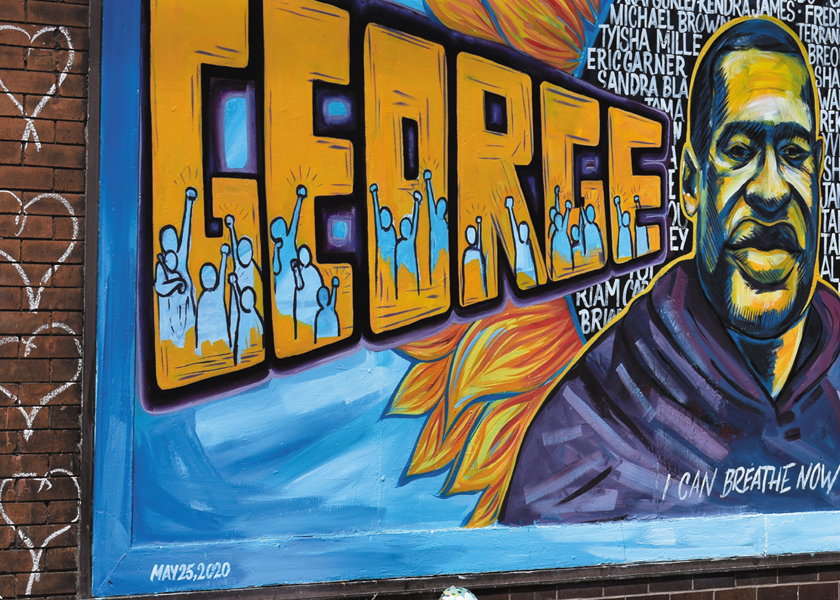The double whammy of pandemic and racial justice riots made for a long hot Minnesota summer | Editor’s Note by Martha Vickery (Summer 2020 issue)

Last time we published was after we were well into the reality of the pandemic, which is now a bit worse in Minnesota compared with three months ago. The additional event in Minnesota that has shocked and then galvanized the Twin Cities community, not to mention the entire world, is the murder of George Floyd and its aftermath of looting and rioting that left the Uptown area and reportedly 1500 locations in St. Paul, Minneapolis and a few suburbs damaged to the tune of as-yet-unknown millions of dollars.
The COVID-19 pandemic has hit retail businesses the hardest. Many restaurants and stores that were unable to refinance or adapt to social distancing requirements closed, probably for good. Then came the riots. The two together were like having a hurricane followed by a tornado.
Buildings along a five-mile stretch of Lake Street in Minneapolis and a 3.5-mile stretch of University Avenue in St. Paul’s Midway area experienced some of the heaviest damage, according to the Star Tribune. Those are also some of the areas with many unique and vulnerable small retailers. The Twin Cities has gone through an economic shock, followed by the destruction of riots, as well as a crisis of conscience that the epicenter of the violence happened here.
So far, our local elected officials have been slow to respond to the sea change happening on the ground in the Twin Cities. The Minneapolis City Council voted to defund the police, but then was slow on proposing an initiative to replace it — there is apparently a year-long study process planned. The legislature had a police reform bill in front of them, and finally passed a very limited version of it July 21, nearly two months after George Floyd’s death. The problems are many, but so far, the solutions are few. I fear that Minnesota has lost the moment it could have grasped to be a national leader on this reform issue.
Several of our essayists in the summer issue are also Minneapolis residents; the church that our board chair Phil Lee attends was on the front lines of providing groceries to residents whose grocery stores were either burned out closed after the initial riots. Another longtime Korean Quarterly writer and copy editor, Tiffany Pauling, wrote about hearing the glass break at the store across the street, and deciding it was time to leave for awhile. Part of the privilege of being middle class in Minneapolis is that you can jump in your car and go stay someplace else. The call to represent can fight with self-preservation sometimes, and our writers talk about that too.
Local thought leader and founder of the Twin Cities organization AdopteeBridge, Christine Heimann, also wrote about a list of issues for Korean Americans to consider in how to represent as a Korean adoptee, within one’s family and out in the community. Thanks to all our local correspondents for providing a needed airing of these emerging topics.
At the same time as this racial justice moment is sweeping the country, there is a more international justice moment to recognize — that 70 years have passed since the beginning of the Korean War, and there is a growing push by peace advocates and elected officials in this country to move the country toward a peace treaty with North Korea, which would be agreed-upon by the governments involved. What is in place right now is an armistice — an agreement to stop shooting at each other. The temporary nature of the armistice is at the core of many unresolved issues between the U.S. and North Korea, and indeed the security of the whole northeast Asia region.
But it is not just politics involved. It is people’s lives. Interestingly, one of the three forums held recently (all online of course) to discuss the history of U.S. involvement and prospects for a peace treaty was one about women’s stories — how their families became Korean American, and how the Korean War profoundly affected their lives.
We have premiered the new Korean Quarterly online edition for a few months now. It looks great, functions well, and positive reviews have poured in.
For me, after seeing color photos be converted to black-and-white for print for so many years, it is surprising to see them in bright color next to the story on the screen. Not being a techie person, I love the logic of the layout and the easy way it operates. There are two words that characterize the last two months for me: Learning curve. You think it looks easy, and then you end up doing the same thing over again a few times. Next time, I may remember how to do it, or I may have forgotten and have to flounder around again. That is the essence of a learning curve. It’s long. It doesn’t happen in one afternoon.
But we are trying, and thanks for being patient with us. It is a big process. I view the website with a strange mixture of delight and anxiety. Overall, it is so worth the work, and it is great to have an online presence. I google my favorite column or story, and there it is! I love it.
So many thanks go out to our webmaster Jason Patocka, who is skilled and fast to notice things that need doing, and also patient in working with all of us. Our organization has always had the right people arrive at the right time. You know who you are, guys.
I’m so done with pandemic well wishes like “stay safe and wash your hands” that I will just say “Have a good rest of the summer!”


